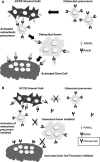Giant cell tumour of bone: new treatments in development
- PMID: 25617146
- PMCID: PMC4448077
- DOI: 10.1007/s12094-014-1268-5
Giant cell tumour of bone: new treatments in development
Abstract
Giant cell tumour of bone (GCTB) is a benign osteolytic tumour with three main cellular components: multinucleated osteoclast-like giant cells, mononuclear spindle-like stromal cells (the main neoplastic components) and mononuclear cells of the monocyte/macrophage lineage. The giant cells overexpress a key mediator in osteoclastogenesis: the RANK receptor, which is stimulated in turn by the cytokine RANKL, which is secreted by the stromal cells. The RANK/RANKL interaction is predominantly responsible for the extensive bone resorption by the tumour. Historically, standard treatment was substantial surgical resection, with or without adjuvant therapy, with recurrence rates of 20-56 %. Studies with denosumab, a monoclonal antibody that specifically binds to RANKL, resulted in dramatic treatment responses, which led to its approval by the United States Food and Drugs Administration (US FDA). Recent advances in the understanding of GCTB pathogenesis are essential to develop new treatments for this locally destructive primary bone tumour.
Figures


References
-
- Larsson SE, Lorentzon R, Boquist L. Giant-cell tumor of bone. A demographic, clinical, and histopathological study of all cases recorded in the Swedish Cancer Registry for the years 1958 through 1968. J Bone Joint Surg Am. 1975;57:167–173. - PubMed
-
- Liede A, Bach BA, Stryker S, Hernandez RK, Sobocki P, Bennett B, et al. Regional variation and challenges in estimating the incidence of giant cell tumor of bone. J Bone Joint Surg Am. 2014;96(23):1999–2007. - PubMed
-
- Turcotte RE. Giant cell tumor of bone. Orthop Clin North Am. 2006;37:35–51. - PubMed
-
- Turcotte RE, Wunder JS, Isler MH, Bell RS, Schachar N, Masri BA, et al. Giant cell tumor of long bone: a Canadian Sarcoma Group study. Clin Orthop. 2002;(397):248–58. - PubMed
Publication types
MeSH terms
LinkOut - more resources
Full Text Sources
Other Literature Sources
Medical

